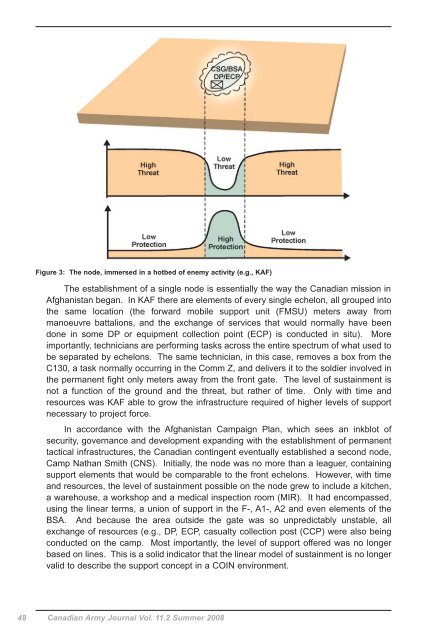Practical Sustainment Concepts for the Non-Linear Battlespace
Practical Sustainment Concepts for the Non-Linear Battlespace
Practical Sustainment Concepts for the Non-Linear Battlespace
You also want an ePaper? Increase the reach of your titles
YUMPU automatically turns print PDFs into web optimized ePapers that Google loves.
Figure 3: The node, immersed in a hotbed of enemy activity (e.g., KAF)<br />
The establishment of a single node is essentially <strong>the</strong> way <strong>the</strong> Canadian mission in<br />
Afghanistan began. In KAF <strong>the</strong>re are elements of every single echelon, all grouped into<br />
<strong>the</strong> same location (<strong>the</strong> <strong>for</strong>ward mobile support unit (FMSU) meters away from<br />
manoeuvre battalions, and <strong>the</strong> exchange of services that would normally have been<br />
done in some DP or equipment collection point (ECP) is conducted in situ). More<br />
importantly, technicians are per<strong>for</strong>ming tasks across <strong>the</strong> entire spectrum of what used to<br />
be separated by echelons. The same technician, in this case, removes a box from <strong>the</strong><br />
C130, a task normally occurring in <strong>the</strong> Comm Z, and delivers it to <strong>the</strong> soldier involved in<br />
<strong>the</strong> permanent fight only meters away from <strong>the</strong> front gate. The level of sustainment is<br />
not a function of <strong>the</strong> ground and <strong>the</strong> threat, but ra<strong>the</strong>r of time. Only with time and<br />
resources was KAF able to grow <strong>the</strong> infrastructure required of higher levels of support<br />
necessary to project <strong>for</strong>ce.<br />
In accordance with <strong>the</strong> Afghanistan Campaign Plan, which sees an inkblot of<br />
security, governance and development expanding with <strong>the</strong> establishment of permanent<br />
tactical infrastructures, <strong>the</strong> Canadian contingent eventually established a second node,<br />
Camp Nathan Smith (CNS). Initially, <strong>the</strong> node was no more than a leaguer, containing<br />
support elements that would be comparable to <strong>the</strong> front echelons. However, with time<br />
and resources, <strong>the</strong> level of sustainment possible on <strong>the</strong> node grew to include a kitchen,<br />
a warehouse, a workshop and a medical inspection room (MIR). It had encompassed,<br />
using <strong>the</strong> linear terms, a union of support in <strong>the</strong> F-, A1-, A2 and even elements of <strong>the</strong><br />
BSA. And because <strong>the</strong> area outside <strong>the</strong> gate was so unpredictably unstable, all<br />
exchange of resources (e.g., DP, ECP, casualty collection post (CCP) were also being<br />
conducted on <strong>the</strong> camp. Most importantly, <strong>the</strong> level of support offered was no longer<br />
based on lines. This is a solid indicator that <strong>the</strong> linear model of sustainment is no longer<br />
valid to describe <strong>the</strong> support concept in a COIN environment.<br />
48 Canadian Army Journal Vol. 11.2 Summer 2008







![La modularite dans l'Armee de terre canadienne [pdf 1.6 MB]](https://img.yumpu.com/17197737/1/188x260/la-modularite-dans-larmee-de-terre-canadienne-pdf-16-mb.jpg?quality=85)









